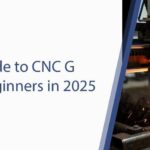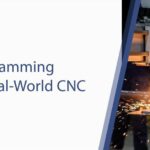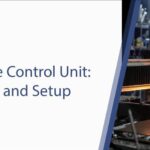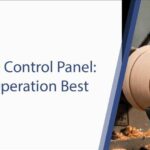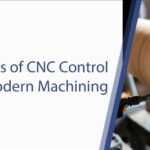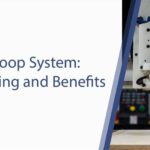The CNC lathe, or turning center, is a cornerstone of modern manufacturing. With its rotating workpiece and stationary tooling, it excels at producing cylindrical parts with incredible speed and precision.
But the magic behind every perfectly turned shaft, threaded bolt, or complex contoured component lies in its programming. The software is the invisible architect, dictating the intricate dance between the spinning material and the cutting tool.
Unlike a CNC mill where the tool does most of the moving, the lathe’s programming paradigm is unique, centered around controlling a spinning workpiece.
Understanding the software that drives this process is crucial for any machinist, engineer, or shop owner looking to maximize efficiency, tackle complex jobs, and ensure flawless results.
As a developer of the advanced CNC controllers that translate this software into motion, Radonix understands that a great program requires an equally great conductor.
This guide will provide a deep dive into the world of CNC lathe programming software, exploring the two primary methods, from traditional manual coding to the power of modern CAM systems, and revealing how the right controller is the ultimate key to mastering the turn.
The Two Paths of Lathe Programming: Manual vs. CAM
When it comes to programming a CNC lathe, machinists generally follow one of two paths. While modern shops lean heavily on the second path, a true master understands the value of both.
- Manual G-Code Programming: This is the foundational method, where the programmer writes the G-code line by line directly into the controller. It requires a deep understanding of machining principles and the specific codes that command the lathe.
- CAM Software Programming: This is the modern, graphical approach. The programmer uses Computer-Aided Manufacturing (CAM) software to generate the toolpaths and G-code automatically from a 2D or 3D model of the part.
Let’s explore each path in detail.
Path 1: The Art of Manual G-Code Programming for Lathes
In an era of automation, why would anyone learn to write code by hand? The answer is simple: for speed on simple jobs, for making quick edits at the machine without going back to a programming station, and most importantly, for fundamentally understanding what the machine is doing.
Key Concepts in Manual Lathe Programming
Programming a lathe manually revolves around a few core concepts that differ from milling:
- The Coordinate System: A standard 2-axis lathe operates on the X-axis (controlling the diameter of the part) and the Z-axis (controlling the length of the part). Z0 is typically the face of the finished part, and X0 is the centerline of the spindle.
- Spindle Speed Control: This is a critical concept in turning.
- G97 (Constant RPM Mode): Sets the spindle to a fixed speed, e.g., G97 S1200 means the spindle spins at a constant 1200 revolutions per minute, regardless of the tool’s position.
- G96 (Constant Surface Speed Mode): This is the preferred mode for finishing. It tells the controller to constantly adjust the RPM based on the tool’s X-axis position to maintain a constant surface speed (the speed at which the material is moving past the cutting edge). This results in a much more consistent and superior surface finish across the entire part.
- Tooling and Offsets: The command T0101 calls up tool number 1 and applies its corresponding geometry offset number 1. These offsets, measured and stored in the controller, tell the machine the exact position of the tool’s cutting tip.
The Power of Canned Cycles: The Programmer’s Shortcut
Writing the code for every single roughing pass on a complex profile would be incredibly tedious. To solve this, CNC controllers are equipped with canned cycles—powerful, pre-programmed routines that execute common operations with just a few lines of code. For lathes, the most important are:
- G71 – Stock Removal in Turning: This is the workhorse of lathe roughing. The programmer defines the final finished profile of the part using a few lines of code, and then a single G71 line tells the machine to automatically perform all the roughing passes needed to remove the bulk material, specifying the depth of each cut and the amount of material to leave for a finish pass.
- G72 – Stock Removal in Facing: This cycle works similarly to G71 but is used for roughing passes along the face of the part (along the X-axis).
- G70 – Finishing Cycle: After the material has been roughed out with G71 or G72, a single G70 command tells the controller to run one final, precise pass along the finished profile, creating a smooth and accurate part.
The Radonix Connection: A controller’s ability to execute these canned cycles smoothly and reliably is paramount.
Radonix CNC controllers feature robust, intuitive, and standard implementations of these essential lathe canned cycles.
Our software makes it easy to input the parameters for G71 and G72, and our advanced motion control ensures the finishing pass with G70 is executed with the utmost precision.
Path 2: The Power of CAM Software for CNC Lathes
For parts with complex curves, multiple features, or when efficiency and safety are top priorities, CAM software is the undisputed champion.
What is CAM for Lathes?
CAM software takes a 2D profile or a full 3D model of the desired part and allows a programmer to graphically generate the toolpaths needed to machine it. It handles all the complex calculations and outputs ready-to-run G-code.
The CAM Workflow for Turning:
- Import or Design: The programmer starts with a CAD model of the part.
- Job Setup: This is a critical step in turning CAM. The programmer defines:
- The cylindrical stock material.
- The chuck or collet that will hold the workpiece, including the position of the jaws.
- The tailstock, if one is being used for support.
- The location of the work coordinate system (Z0, X0).
- Machining Strategy Selection: The programmer chooses from a library of specialized turning operations:
- Roughing: To quickly remove bulk material.
- Finishing: To create the final profile.
- Grooving: To cut grooves or specific features.
- Threading: To generate precise internal or external threads.
- Drilling: For creating holes along the centerline.
- Parting Off: Using a special tool to cut the finished part off from the rest of the stock.
- Simulation: CAM software provides detailed, animated simulations. This is incredibly important for lathes, as it allows the programmer to check for potential collisions between the cutting tool, the workpiece, the chuck jaws, and the tailstock. This verification step saves thousands in potential damages and scrap parts.
- Post-Processing: Once the simulation is verified, the CAM software uses a lathe-specific post-processor to translate the graphical toolpaths into the precise G-code dialect that the target controller, like a Radonix controller, will understand.
Popular CAM Software with Strong Lathe Modules: Mastercam, GibbsCAM, SolidCAM, SprutCAM, Autodesk Fusion 360 & HSM.
Advanced Lathe Programming: The Rise of the Mill-Turn Center
Modern CNC lathes, often called “mill-turn” centers, have blurred the lines between turning and milling, adding incredible capability but also significant programming complexity.
- Live Tooling and C-Axis Milling: These machines feature a turret with “live tools”—milling cutters or drills that can spin independently of the main spindle. The main spindle can then be stopped and controlled as a rotational C-axis. This allows the machine to perform milling operations, drill off-center holes, and engrave on the face or diameter of the part, all in a single setup.
- Y-Axis Machining: Adding a Y-axis to the turret’s movement (perpendicular to the X-axis) allows for true milling of complex features that are not on the part’s centerline. It essentially gives the lathe the capabilities of a 3-axis mill.
- Sub-Spindles: High-production machines often feature a second, opposing spindle (a sub-spindle). After the front side of a part is machined, the sub-spindle can move in, grab the part, and pull it away from the main spindle. The machine can then perform all the necessary “back-side” machining operations, dropping a completely finished part at the end of the cycle.
Programming these multi-axis, multi-spindle machines by hand is virtually impossible. This level of complexity demands a high-end CAM system capable of synchronizing all these simultaneous operations.
The Radonix Connection: The challenge of mill-turn machining falls squarely on the controller. It must process enormous amounts of code while perfectly synchronizing the main spindle’s rotation, the live tool’s speed, and the movement of the X, Z, C, and Y axes. The powerful processing core and advanced kinematics of Radonix PC-based controllers are specifically designed to handle these demanding multi-axis applications. Our platform provides the computational power and real-time performance necessary to execute complex mill-turn programs without hesitation or error.
The Conductor of the Orchestra: The Role of the CNC Control Software
Whether your G-code was meticulously handwritten using canned cycles or generated by a sophisticated CAM system, it is nothing more than a text file until it is loaded into the control software. The controller is the conductor that reads the musical score and brings it to life.
A controller’s performance is especially critical for turning operations:
- Perfect Spindle Synchronization: For threading, the Z-axis movement must be in perfect, unwavering sync with the spindle’s rotation. Any deviation results in a faulty thread. The hard real-time environment created by Radonix controllers ensures this synchronization is flawless.
- Responsive Constant Surface Speed (G96): To maintain a beautiful surface finish, the controller must adjust the spindle RPM instantly as the tool moves along the X-axis. Radonix controllers excel at this, providing the responsive performance needed for a mirror-like finish.
- Intuitive Interface: A great lathe controller should make the operator’s life easier. The Radonix graphical interface makes it simple to manage complex tool libraries, accurately set tool and work offsets, and visualize the toolpath before pressing “Cycle Start,” minimizing the risk of costly setup errors.
Conclusion: The Ultimate Union of Software and Control
The world of CNC lathe programming offers a path for every need—from the elegant simplicity of manual G-code and canned cycles for quick jobs, to the immense power of CAM software for complex and multi-axis mill-turn components.
However, the journey from a digital program to a finished part always has a final, crucial step: execution by the CNC controller. The most sophisticated CAM program is rendered useless by a controller that cannot keep up, cannot maintain perfect synchronization, or cannot process complex movements with absolute reliability.
Your design, your program, and your machine’s potential all depend on the quality of that final execution. By pairing your programming efforts with an intelligent, powerful, and precise control system, you ensure that every turn is a masterpiece.
Whether you are programming simple shafts or complex, multi-axis components, your software is only as good as the controller that brings it to life.
Contact Radonix today to learn how our advanced CNC control solutions can provide the precision, power, and reliability your turning operations demand.
Contact Us:
- E-Mail: info@radonix.com
- Phone: +90 (553) 920 5500


